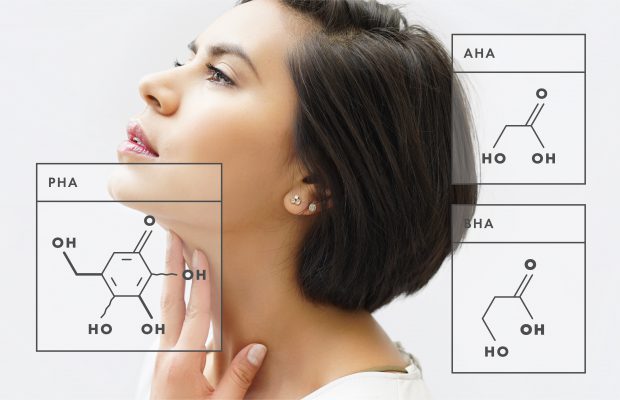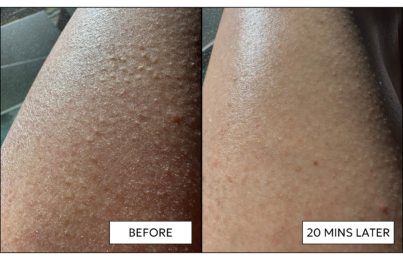Updated 03/15/23. I remember when exfoliating acids first emerged on the scene in the early ‘90s. In fact, in 1992, when I first got my hands on a professional-grade glycolic acid peel, I ended up burning the skin on my face (oops). I was new to acids—as was the rest of the professional skincare world—and I didn’t really know what I was doing yet. Nevertheless, I continued to use and learn about acids, and 30 years later, I’ve never repeated that first mistake.
- Meet the Acids
- Exfoliating Acids FAQ
- How Do Exfoliating Acids Work?
- What Are the Benefits of Acids?
- Which Acids Are Safe for Pregnancy?
- Which Acids Are Best for Younger Skin? What About Mature Skin?
- I Have Sensitive Skin. How Can I Use Acids?
- Should I Use Acids in a Toner or Serum?
- At What Age Should I Start Using Acids?
- How Can I Tell if I’m Using Acids Too Often?
- Do Dry Patches Mean You Should Exfoliate Less?
- Can I Use More Than One Type of Acid?
- Should I Use Acids in the AM or PM?
- At What Step in My Routine Should I Use Acids?
- Can I Use Exfoliating Acids if I Use Retinoids?
- Can I Use Acids With Vitamin C?
- Can I Use Acids in the Summer?
- Will Acids Help With PIE or PIH?
- Will Acids Help With Blackheads and Sebaceous Filaments?
- Can I Use Acids on My Neck? What About My Body?
- Can I Use Acids Around My Eyes?
- Are Acids Vegan?
- Can Your Skin Get Used to Acids? Should You Switch Them Up for Better Results?
- The Bottom Line
As popular as they are, there’s a lot to know about exfoliating acids and how to use them correctly. To clear things up, I compiled a list of the questions I get asked the most—along with in-depth answers. I hope you find the clarity you’re looking for!
Meet the Acids
Before diving into FAQs, I thought I’d go back to basics and give a brief description of each type of exfoliating acid.
1. Alpha Hydroxy Acids (AHAs)
Alpha Hydroxy Acids, also known as AHAs, are a group of organic acids discovered in natural foods but typically created synthetically for use in cosmetic products. One shared characteristic of AHAs is that they’re water-soluble. They’re the most popular class of acids used in skincare thanks to their ability to address a variety of skin concerns. This includes dry or dull skin, fine lines, wrinkles, uneven skin texture, post-breakout marks, and hyperpigmentation.
- Lactic Acid: This AHA is naturally derived from milk. Lactic acid gently dissolves dead cell buildup on the surface of the skin. It’s also a natural moisturizing factor (NMF), meaning it’s good for hydration and barrier repair. In other words, if you have sensitive skin, lactic acid is a great choice.
- Glycolic Acid: Glycolic acid is naturally derived from sugar cane and has the smallest molecule size of any AHA. This means it can penetrate deeper into the skin, making it more potent but also potentially more irritating. Glycolic acid is especially effective at targeting issues like hyperpigmentation, fine lines, and wrinkles. Glycolic acid is also particularly good at stimulating collagen growth over time.
- Mandelic Acid: Mandelic acid is naturally derived from bitter almonds and is very gentle. It works best when combined with other exfoliating acids. It can play a supporting role in suppressing pigmentation. Some studies have shown it can also help with breakouts.
- Malic Acid: Malic acid is naturally derived from apples and works well as a humectant (meaning it can retain moisture). It also works well as a pH adjuster in products. This acid is best for aging, pigmentation, and dryness.
- Tartaric Acid: Tartaric acid is naturally derived from fermented grapes, which means it also has antioxidant properties. It’s a gentle, mild exfoliator that can also be used as a pH adjuster.
Beta-Hydroxy Acids (BHAs)
The key difference between AHAs and BHAs is that BHAs are oil-soluble. This means that, instead of working exclusively in the upper layers of the skin, BHAs can cut through the skin’s natural oils and penetrate into the pore lining to dissolve blockages. If breakouts, clogged pores, and oily skin are your main skin concerns, a BHA is hands-down the best option for you.
- Salicylic Acid: Salicylic acid is the only BHA available in skincare. It’s naturally derived from willow bark, although a synthetic version is used in cosmetic products today. It’s great for dissolving keratin plugs inside pores. Salicylic acid also has antibacterial and anti-inflammatory properties. One thing to be aware of is that salicylic acid can cause dryness, so look for a formula that includes hydrating ingredients.
Polyhydroxy Acids (PHAs)
Polyhydroxy Acids (PHAs) are a lesser-known group of exfoliating acids that were patented by NeoStrata around 1994 (though they were first discovered in the early ’70s).
PHAs target many of the same issues as AHAs, but they are larger molecules. This means they’re incredibly gentle and unlikely to cause irritation. Their claim to fame, however, is that this doesn’t make them any less effective as exfoliators. They even function as humectants to hydrate the skin.
The two PHAs typically used in skincare formulations are gluconolactone and lactobionic acid. Because they’re structurally similar to AHAs, PHAs are sometimes positioned as a milder alternative. PHAs also offer antioxidant benefits.
If you have very sensitive skin or even rosacea, PHAs may be an ingredient for you to consider. You can find PHAs (gluconolactone) in the Triple Berry Smoothing Peel.
Azelaic Acid
Azelaic acid and its derivatives are a class of their own. They can be found in wheat and rye and, in small amounts, is naturally present in the yeast on our skin. While it exfoliates the skin, this isn’t its main claim to fame. Instead, it’s famous for its antibacterial properties that can benefit breakout-prone skin.
It’s great for those with crossover conditions because it’s a very soothing ingredient that has the ability to calm redness and irritation. In fact, it’s often used in prescriptions at 15% to treat rosacea, although the mechanism is unknown. So, if you’re someone who deals with both acne and rosacea, this could be a beneficial ingredient for you.
Azelaic acid is also very effective at treating hyperpigmentation, whether it’s melasma, sun damage, or post-breakout marks. In fact, some studies have shown that, in certain concentrations, azelaic is more effective than hydroquinone, which is a prescription skin brightener!
Azelaic acid is safe to use if you’re pregnant or nursing, so it can be a good alternative to other ingredients.
You can find an azelaic acid derivative (potassium azeloyl diglycinate) in the Triple Berry Smoothing Peel.
Exfoliating Acids FAQ
Here are the most-asked questions I get about exfoliating acids.
How Do Exfoliating Acids Work?
Exfoliating acids work by lowering the pH of the skin. To work effectively, an exfoliating acid must have a pH below 4 (our skin’s natural pH hovers right around 5). They put the skin into an acidic state. This dissolves the bonds (or “glue”) that hold dead skin cells together. From there, the expired cells shed to reveal the fresh, new cells underneath.
Our skin has a natural exfoliation process called desquamation. All this means is that new cells are born in the deepest layers of our skin, slowly working their way to the surface until they push out old, expired cells. This process slows down as we age (or is naturally slow for some people to begin with, which can contribute to breakouts). Exfoliating acids help us shed dead skin cells more efficiently, encouraging the skin to act in a younger, healthier way.
What Are the Benefits of Acids?
Exfoliating acids can benefit the skin in so many ways. They can:
- Improve hydration by removing surface dryness (many AHAs also act as humectants)
- Fade pigmentation from post-breakout marks or sun damage
- Reduce the appearance of large pores, fine lines, and wrinkles
- Encourage a brighter-looking complexion
- Improve overall skin texture
- Reduce redness and breakouts
- Prevent clogged pores by removing dead skin cells that could otherwise fall into pores and block them
- Increase the efficacy of other skincare products by removing the barrier of dead skin cells
Which Acids Are Safe for Pregnancy?
ALL except salicylic acid. Be sure to talk with your doctor though because some have different viewpoints about this.
Which Acids Are Best for Younger Skin? What About Mature Skin?
Everyone’s skin is different, so there isn’t one blanket answer. However, my best advice would be to observe the pH level of an acid product as well as the percentage of acid included.
When you’re younger, your skin has less of a need for acids. Generally, your cell turnover is already functioning well, unless you have clogged pores and breakouts. Young skin also tends to be oilier, so I recommend BHA (salicylic acid) since it’s oil soluble and can really get into the pores to clean them out. However, younger skin can be more reactive to active ingredients, so go easy. You can still use AHAs, just look for a formula that is gentle with a lower percentage of acids.
Mature skin, on the other hand, should focus more on AHAs. This will help shed dead skin and build collagen. Even though the dermis is thinner in older skin, the epidermis is thicker and harder to penetrate. This means mature skin can generally tolerate a higher percentage of acids.
To give you an idea of percentages, I usually recommend the Pro Results Power Serum to my mature clients who are dealing with sun damage and wrinkles. It includes a 20% AHA blend. For clients in their late twenties or early thirties, I recommend the Pore + Wrinkle Perfecting Serum. It includes a 17% AHA blend (and includes salicylic).
I Have Sensitive Skin. How Can I Use Acids?
Sensitive skin can benefit from exfoliation as much as any other skin type, but there are a few guidelines to keep in mind so you don’t end up doing more harm than good.
First and foremost, you shouldn’t exfoliate every day. That goes for everyone, regardless of skin type. No one builds up dead skin cells quickly enough to exfoliate this often, and you’ll just end up damaging your skin’s protective barrier. Limit your use of exfoliating acids to three or four times a week (five at the most).
Second, make sure you’re using the right formula for your skin type. Lactic acid is a great choice for sensitive skin and can even work well for those with rosacea. It has soothing, hydrating properties and, when used correctly, can help repair barrier damage, which is often the underlying cause of sensitivity. You can still use a formula that includes multiple acids; just look for one that’s heavier on lactic.
Finally, keep the pH and percentage in mind. The lower the pH of a product and the higher the percentage of acids included, the more potent the formula. These are two factors you can play around with until you find the sweet spot for your skin.
Should I Use Acids in a Toner or Serum?
I advocate exfoliating acid serums over toners for a couple of reasons. The first is that an exfoliating serum is less likely to cause irritation. The second is that they work deeper and more effectively than an acid toner.
Exfoliating acid toners are more likely to irritate the skin because they provide a quick hit of acids all at once. While a lot of people like the quick results they give, they can also quickly damage your barrier. Acid toners are usually water-based, so they evaporate quickly and don’t provide long-lasting benefits. This water evaporation can also leave your skin feeling tight and dehydrated.
Exfoliating acid serums, on the other hand, tend to have a thicker consistency that can coat the skin and allow for a slow, steady release of acids. This means less irritation, longer-lasting results, and an added benefit of hydration to keep skin acting healthy.
At What Age Should I Start Using Acids?
If you have breakouts and clogged pores, you can start using salicylic acid as early as 15 years old. This will be beneficial for clearing and preventing clogged pores as well as fading post-breakout marks. If you don’t deal with breakouts and are just using acids for a smoother texture, the youngest I would start is probably 20 years old.
How Can I Tell if I’m Using Acids Too Often?
As I mentioned, daily exfoliation is too much. While using acids properly can help strengthen your skin’s barrier, overusing them can damage it. The line between the two can be a fine one, but here are some signs you may be exfoliating too often:
- Stinging: It’s normal for acid products to tingle when applied to the skin, but this should subside as you use them regularly. If you keep getting a stinging sensation, you may want to dial it back.
- Dryness: Again, the proper use of acids should improve your moisture barrier and improve your skin’s ability to hold on to hydration. If your skin is getting drier, dial it back.
- Redness: This could be a sign that you’re overdoing it and actually giving your skin micro-burns. If your skin keeps getting redder in its appearance, this might be a sign of overuse.
Do Dry Patches Mean You Should Exfoliate Less?
This is a tough one. Acids can be used to correct dryness, but dryness can also be one of the signs you’re overusing them. If you’re getting dry patches in addition to redness or stinging, try cutting back.
On the other hand, you might need to add a physical exfoliant into the mix. Some people shy away from them, but I believe facial scrubs are incredibly beneficial. They can physically lift off dry and discolored skin cells once they’ve been loosened up by acids. If you’re dealing with dry patches, try a gentle facial scrub with round, biodegradable beads, like the Triple Berry Smoothing Scrub.
FYI, there are three types of exfoliants: acids, enzymes, and physical scrubs. Learn which exfoliant should you use and how often.
Can I Use More Than One Type of Acid?
Yes, I encourage it! All of my exfoliating acid serums are formulated with more than one type of acid to give maximum benefits. For example, salicylic acid can clear the way for AHAs like glycolic and lactic by cutting through oil and penetrating the pore lining. Combining glycolic acid with other AHAs can be beneficial since it has a smaller molecule size. Adding lactic acid to an exfoliating acid product can make it more hydrating.
The key is to look for a product that’s heavier on the type of acid that caters to your specific skin concerns.
Should I Use Acids in the AM or PM?
My philosophy is that acids are better for nighttime use. Think about what your skin is doing during the day versus at night. Daytime is all about protection and preventing environmental damage. Nighttime is all about repair. Acids can put your skin in a slightly more vulnerable state by exposing fresh cells, which is not what you want in the morning. I definitely consider acids to be more reparative than protective.
At What Step in My Routine Should I Use Acids?
After cleansing your face and applying an alcohol-free toner, your acid product should be the first thing touching your skin. Wait about one minute before applying your next product. A good exfoliating acid serum should provide hydrating benefits as well as exfoliation, but if you’re using a hydrating serum, apply that next. Moisturizer will be your last step.
Can I Use Exfoliating Acids if I Use Retinoids?
Yes, in fact, you should absolutely use both to get the best results (just not at the same time). Retinol and prescription retinoids work from the inside out, increasing the rate at which new skin cells come to the surface. This means that the rate at which expired cells build up on the surface of the skin also increases, so it’s essential they’re sloughed off using exfoliating acids and a gentle, skin-polishing scrub.
Read more about how to successfully use both retinoids and acids.
Can I Use Acids With Vitamin C?
Yes, but with a few caveats. As I already mentioned, I believe exfoliating acids should be used at night to help the skin repair itself. Vitamin C is great at defending the skin against environmental damage, so it should be used in the morning. Just be careful about what kind of vitamin C you use. Like exfoliating acids, it’s an acidic ingredient, and putting the skin in too much of an acidic state can cause damage and irritation. L-ascorbic acid is usually the biggest culprit when it comes to irritating people’s skin because it’s very acidic and unstable.
Here are five things to look for in a vitamin C serum if you use acids.
Can I Use Acids in the Summer?
Yes, as long as you’re diligent about sunscreen use! The whole point of acids is to improve and repair the skin, and the summer sun is obviously a huge source of skin damage. Acids are a useful tool for combatting this damage, but only if you use sunscreen to protect your skin in the first place.
Will Acids Help With PIE or PIH?
Post-inflammatory erythema (PIE) is the term for red marks left behind by blemishes or other injuries to the skin. Post-inflammatory hyperpigmentation (PIH) refers to the dark, pigmented marks that sometimes form after PIE and tend to linger for a long time. Exfoliating acids can help with both, but more so PIH. All acids will help, but glycolic acid is especially effective at fading pigmentation.
Learn more about what you can do to fade post-breakout marks.
Will Acids Help With Blackheads and Sebaceous Filaments?
Yes, specifically salicylic acid since it’s oil soluble and can penetrate the pore lining. Both blackheads and sebaceous filaments must be manually extracted, but using a salicylic acid serum a few times a week will keep pores clear.
Can I Use Acids on My Neck? What About My Body?
Acids can be used on the neck, but I recommend patch testing first because this skin can be quite sensitive. It may not be able to tolerate the same strength of acids as the skin on the face. You also may not want to exfoliate this area as often.
As for the body, acids work great to smooth texture! They work very well for bumps caused by keratosis pilaris.
Can I Use Acids Around My Eyes?
I’m actually a huge fan of using an under-eye exfoliator, like the Overnight Eye Serum. It’s a great way to minimize fine lines and wrinkles and to ensure your eye cream performs efficiently. Just be sure to follow up with an eye cream after use.
However, there are a few guidelines you need to follow for proper use. First and foremost, don’t get too close to the under-eye area. Your lashes can pick up and transfer products containing acids to the eyes, which can cause stinging. Bring a product up to—but not past—the orbital bone. Secondly, I only recommend using acid products that were specifically formulated for this area. They’re generally more gentle.
Are Acids Vegan?
For the most part, yes. In its natural form, lactic acid is derived from milk, so it wouldn’t be vegan. However, the majority of lactic acid used in cosmetic products is synthetically produced (AKA it’s vegan). Just be sure to look at the other ingredients in the formula since these may not be vegan.
Learn more about vegan skincare products.
Can Your Skin Get Used to Acids? Should You Switch Them Up for Better Results?
In general, your skin can get used to acids in the sense that it becomes stronger. This does not mean, however, that the acids you’re using are any less effective. Using a product long-term does not make your skin “immune” to it.
The only reason you would need to switch up the type of acid you’re using is if your skin’s needs have changed. If you’ve been using an acid product for a while and aren’t getting the desired results, you may just need a formula with different percentages.
The Bottom Line
In summary, I’m a big fan of exfoliating acids. I am 53 and I truly believe that using them for the past 30 years has greatly contributed to the appearance and condition of my skin as it is today. I love all the wonderful benefits exfoliating acids can provide, and I hope this post makes it easier for you to figure out what works for you!
Next, donut, dolphin, and jello skin—learn why the dewy look is trending (and how to get it).
Celebrity Esthetician & Skincare Expert
As an esthetician trained in cosmetic chemistry, Renée Rouleau has spent 35 years researching skin, educating her audience, and building an award-winning line of products. Her hands-on experience as an esthetician and trusted skin care expert has created a real-world solution — products that are formulated for nine different types of skin so your face will get exactly what it needs to look and feel its best. Trusted by celebrities, editors, bloggers, and skincare obsessives around the globe, her vast real-world knowledge and constant research are why Marie Claire calls her “the most passionate skin practitioner we know.”




Comments:
So I am 36 never had acne ever until the passed few years!! And it’s only around my mouth and it’s cystic🤯 I am deeply sad bc I have olive skin tone and hardly have any scars but bc of the cystic acne popping up I have started trying to fix it!! I literally have only used alcohol all my life to clean and keep my face oil free!! Now that I am desperate and have had to start trying something different I am completely in tears!! Recently started using benzoyl peroxide neutrogena almost daily along with la roche-posay and follow it with the ordinary niaminicde and zinc (caused my skin to purge which felt good problemsome but good) at first I used them a lot but I stopped abruptly bc I am now causing more damage than anything!! I’m devastated and I’m about to see my regular doctor to get some advice! I like getting sun on my face never struggled with dark spots or anything until I started playing with stuff I have no clue about!! But cystic acne around the mouth is just horrible I can have one pimple actually be 4 pimples in one it’s just consuming my mind!! Please help with any advice or problem solving skills you may be knowledgeable with!! Thanks Spring
Posted By: Spring Curtis |
Since you struggle with cystic breakouts you should check out the ultra-gentle Anti-Bump Solution! You also sound like a great candidate for a My Skin RX appointment. You can learn more about My Skin RX here.
Posted By: Ella Stevenson |